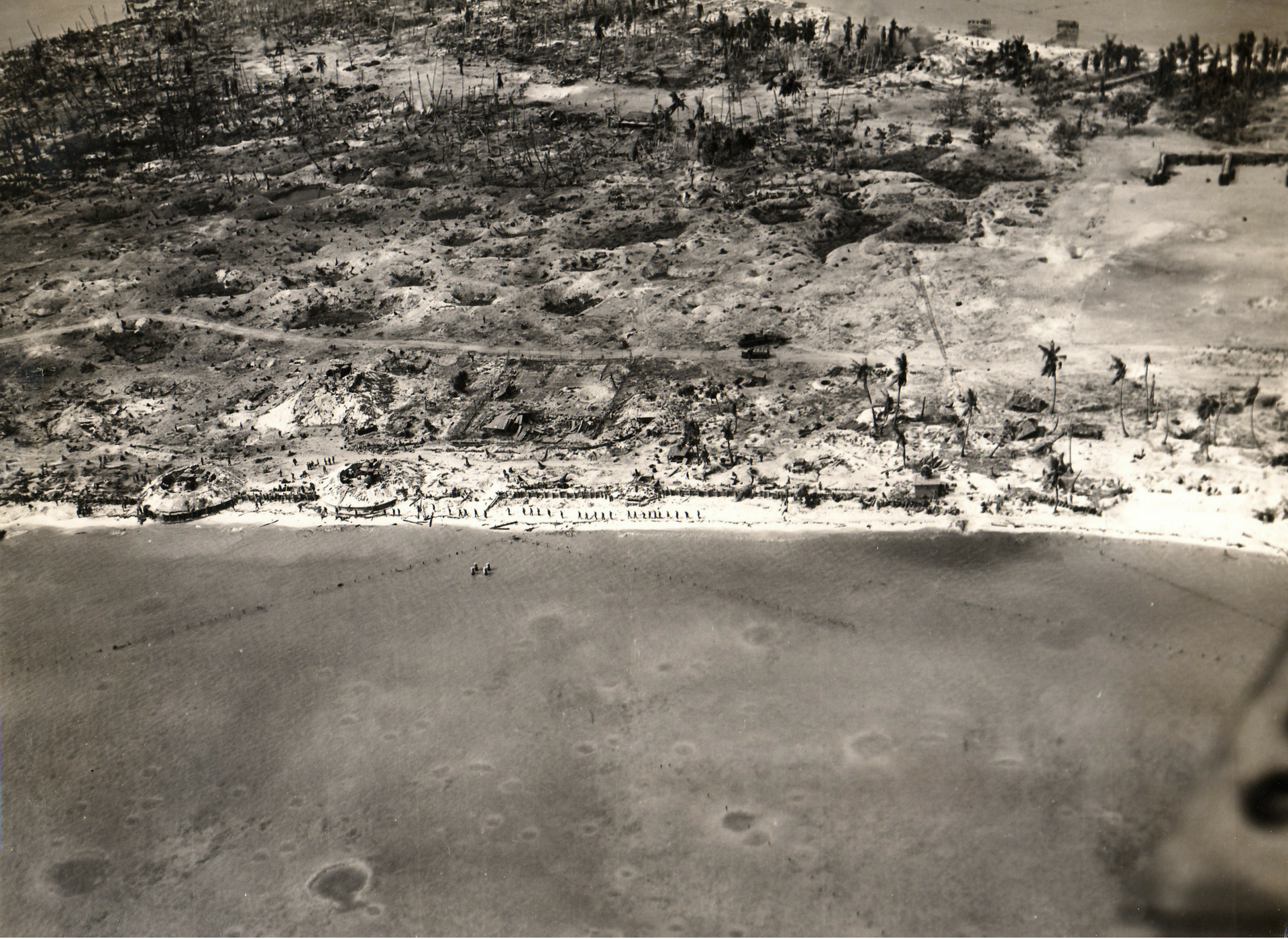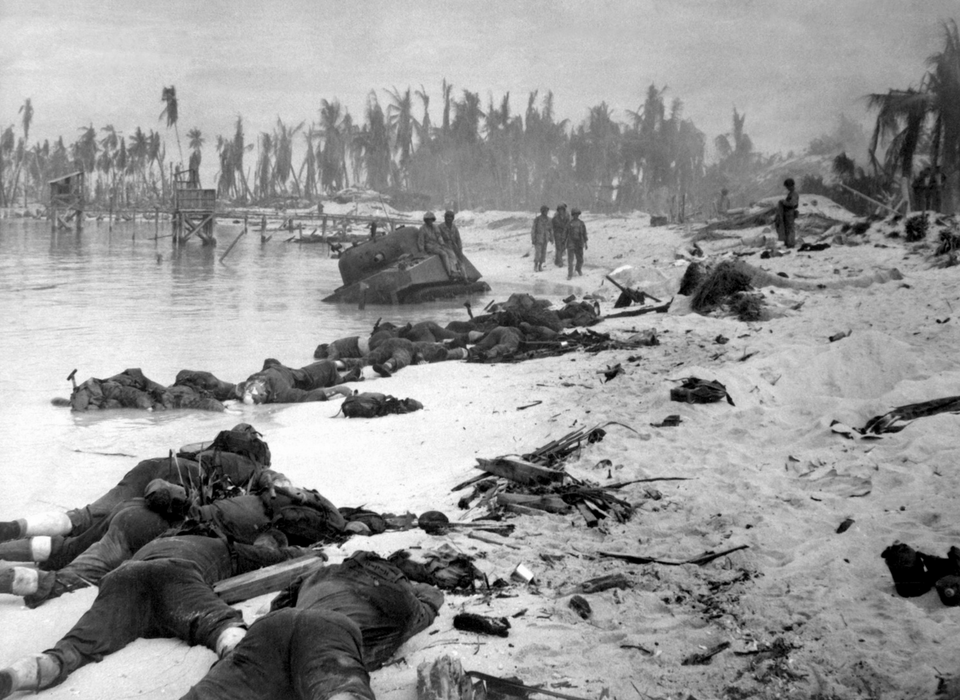View of the beach of Betio Island, Tarawa Atoll, Gilbert Islands, after the US invasion in November 1943.
You’ve heard the cliché: “A picture is worth a thousand words.” You can talk until you’re blue in the face, spouting every lurid descriptor you can summon, and still not get the point across to your listeners. Then they SEE it, and they know.
Welcome to Tarawa.
It’s November 1943, the Pacific war has been raging for two years, and the writing is on the wall. The US military has recovered from Pearl Harbor, battered the Japanese fleet at Midway, and punched a hole in the enemy defense perimeter at Guadalcanal. As 1943 draws to an end, Admiral Chester W. Nimitz begins his great drive across the central Pacific by targeting the Japanese-held Gilbert Islands. The Gilberts will be a stepping stone into the Marshall Islands, which will, in turn, open up the Mariana island chain and put Japan within US bomber range.
The focal point in the Gilberts is the tiny coral atoll of Tarawa. The Japanese aren’t here to win. They intend to kill as many Americans as possible, and then die. The Americans have it a little better. Attacking a tiny island leaves no room to juke or dance around. The Americans will attack Tarawa frontally, and a frontal assault, even if it works, is guaranteed to be bloody.
The Japanese have dug in as deeply as you can on a coral atoll. Two units (the 3rd Special Base Defense Force and the 7th Sasebo Special Naval Landing Force, about 3,000 men in all) anchor their defenses on Betio, the main island in the Tarawa Atoll. They have done their work well, placing 14 coastal defense guns dug in concrete firing positions, building 500 stockades from logs and sand, scattering 40 artillery pieces around the island in firing pits. Trenches link all the defensive strongpoints, allowing the defenders to communicate and move under cover. There is even an airstrip in the center of the island, the main reason Nimitz has chosen to assault it. It is an impressive array for such a petite island: Betio is only two miles long and 800 yards wide. The Japanese commander, Rear Admiral Keiji Shibazaki, is confident, telling his men, "it would take one million men one hundred years" to conquer Tarawa.
Uncle Sam disagrees. The victory at Midway has handed Nimitz the initiative in the world’s largest ocean, letting him pick and choose his targets. The United States amasses a vast array of land, sea, and air power: 17 aircraft carriers, 12 battleships, 66 destroyers, plus 36 types of transport carrying the 2nd Marine Division and parts of the U.S. Army's 27th Infantry Division. The United States has over 30,000 men in the Gilberts, a 10-1 advantage over the defenders.

Aerial view of Betio, Tarawa Atoll, 24 November 1943, looking north toward "The Pocket", the last place of Japanese resistance. Image: U.S. Navy National Museum of Naval Aviation photo.
But remember the type of battle we’re discussing: an amphibious landing, a frontal strike against fully prepared defenders. The Americans open up early in the morning of November 20 with a heavy air raid on Betio, followed by a sustained, 3-hour naval bombardment. It does terrific damage, smashing the Japanese communications net, but the Japanese defenders are sitting in deep bunkers, and many survive to man the guns just as the first Marines hit the north shore.
For the U.S., the wheels come off early. The main problem is the coral reef around Betio. The Higgins Boats which carry the Marines draft four feet of water, and need at least five feet for navigation. This day sees a neap tide, however, and the ocean stubbornly remains just three feet deep. The landing craft hangs up on the coral, while Japanese gunfire pounds away. The Marines on board hop off and desperately try to free their boats. When that fails, they decide to jump off the boats and wade ashore, over the coral reef and into the deeper water of the lagoon. They are 800 yards from shore, holding their rifles aloft, trudging forward in chest deep water. Enemy fire rakes them the entire time, killing and maiming. A few amphibious tractors, “Alligators,” manage to get over the reef, but they get stuck before the seawall reinforcing Betio’s shoreline. Japanese fire is grim, merciless. At day’s end, the American force has barely gotten ashore. Of the 5,000 Marines who attempted to land, some 1,500 are killed or wounded.
The Marines will go on to win this fight. They are superb troops, well trained and equipped. The Japanese defend tenaciously, fighting to the last man, but the Marines grind them down in four days of tough fighting.
No surprise there, but what happens afterwards, is. One Marine on Tarawa isn’t carrying a rifle at all, but a hand-cranked 16mm camera. Staff Sergeant Norman T. Hatch is a Marine cinematographer. He films the entire battle, capturing, for the first time, the horror of a “storm landing” on a Pacific islet.
The result is so shocking that the Marines don’t want to release it. The film “With the Marines at Tarawa” presents the chaos of men under fire. You’ll learn a lot about combat in the Pacific in World War II. But it’s the bodies you’ll remember: twisted lumps that used to be human beings. Bodies floating in the water, bodies half-submerged, bodies contorted in impossible positions on the sand. Even President Roosevelt isn’t sure about it. Are the American people ready for this? Will such grisly scenes turn them against the war effort? He eventually decides yes, every man and woman in America has to understand what it will take to win this war: friends, family, and loved ones blown to bits on far-flung beaches or remote prairies, dying alone, crying for their girlfriends or wives or their mothers.
The film puts somber narration over these horrific scenes: “These are Marine dead,” a voice intones. “This is the price we have to pay for a war we didn’t want.”
Eloquent, to be sure. But in the end, you can watch this movie over and over again, or read every one of the numerous histories of this epic battle, and barely remember the words. Maybe it’s a human thing, but in the end, Tarawa will always be about the pictures.
Robert Citino, PhD
Robert Citino, PhD, is the former Samuel Zemurray Stone Senior Historian in the Jenny Craig Institute for the Study of War and Democracy.
Cite this article:
MLA Citation:
APA Citation:
Chicago Style Citation:







![Max Fuchs, New York City cantor, sings as Rabbi Sydney [sic] Lefkowitz, Richmond, VA, conducts the first Jewish services from Germany.](/sites/default/files/styles/max_650x650/public/2025-10/image1.jpg)

